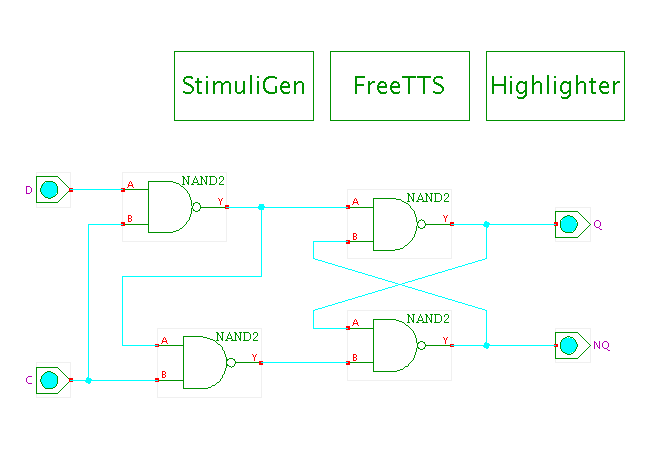TAMS / Java / Hades / applets (print version): contents | previous | nextD-type latch (with text-to-speech explanations)
 Description
The applet on this webpage demonstrates how to integrate
the Hades simulation framework with the
FreeTTS
text-to-speech synthesizer.
This results in a multimodal learning environment,
where the interactive simulation with its animation and visualization
is accompanied by context-sensitive speech output and explanations.
Description
The applet on this webpage demonstrates how to integrate
the Hades simulation framework with the
FreeTTS
text-to-speech synthesizer.
This results in a multimodal learning environment,
where the interactive simulation with its animation and visualization
is accompanied by context-sensitive speech output and explanations.
The circuit shown and explained here is the standard D-type latch,
built from four NAND2 gates.
For a textual explanation without the text-to-speech comments,
please
click here.
Setup
If the simulation and animation works when running the applet,
but you can't hear the speech output,
you have probably not yet changed the security settings of your browser's
Java virtual machine.
The speech synthesis in FreeTTS relies on a few operations
(audio output, but also property accesses etc.)
that are forbidden for untrusted applets.
Therefore, to really run this applet with speech-output enabled,
you might have to edit your Java security configuration file.
The easiest way is to use our
Java Policy Editor,
which helps you to edit the security settings.
If audio output still does not work on your system, please also
check the following:
- check that audio functions are enabled by your operating system.
- check volume controls and speaker/headphone cables.
- on Linux, stop all other programs that play audio (e.g. mp3 playback),
then restart the Hades application or your browser (Hades applet).
On many Linux systems, several incompatbile drivers (e.g. alsa/oss/artsd)
are installed, and a running application will often access the sound
device directly instead of accessing it via a mixer device.
In such cases, other applications are denied access to the sound device.
If the applet doesn't work at all,
and you are sure that Java is enabled in your browser,
chances are that the applet simply did run out of memory.
The default memory limit of 64 MBytes used for Java applets
is a bit low when running Hades with text-to-speech output,
because the speech dictionary, phoneme data, and audio sample buffer
are all pretty large.
Please check the
applet usage page
for information about increasing the memory limit;
a value of 128 or 256 MBytes should be fine.
Run the applet | Run the editor (via Webstart)
Impressum | 24.11.06
http://tams.informatik.uni-hamburg.de/applets/hades/webdemos/00-intro/15-freetts/latchdemo_print.html



 Description
The applet on this webpage demonstrates how to integrate
the Hades simulation framework with the
FreeTTS
text-to-speech synthesizer.
This results in a multimodal learning environment,
where the interactive simulation with its animation and visualization
is accompanied by context-sensitive speech output and explanations.
Description
The applet on this webpage demonstrates how to integrate
the Hades simulation framework with the
FreeTTS
text-to-speech synthesizer.
This results in a multimodal learning environment,
where the interactive simulation with its animation and visualization
is accompanied by context-sensitive speech output and explanations.